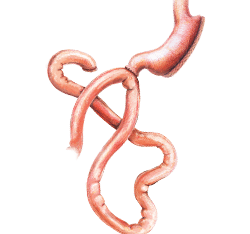Ask a question or Book an Appointment
Please fill in the online enquiry form to ask a question or book an appointment. We look forward to seeing you soon.
OR CALL TODAY ON

Single Anastomosis Duodeno–Ileal Bypass with Sleeve Gastrectomy FAQs
Learn more about SADI-S here.
Single Anastomosis Duodeno–Ileal Bypass with Sleeve Gastrectomy, or SADI-S as it is commonly known, is a modified version of the duodenal switch procedure. SADI-S combines the benefits of both intestinal bypass and sleeve gastrectomy to effectively treat morbid obesity. During the procedure, a large portion of the stomach is removed in order to reduce one’s capacity to eat and to reduce one’s level of ghrelin (the hunger hormone), while the top part of the small bowel is divided so that food bypasses part of the small intestine. This works by reducing the number of fats, sugar and calories that are absorbed by the body.
Single Anastomosis Duodeno-Ileal Bypass with Sleeve Gastrectomy (SADI-S) surgery is generally considered to be irreversible. This is because the procedure involves the permanent alteration of the digestive system, including the creation of a new connection between the duodenum and the ileum.
Whilst it is technically possible to reverse SADI-S surgery, it is a complex and risky procedure that is generally only considered in rare cases where there are significant complications or side effects.
It’s important to note that SADI-S surgery, like other weight loss surgeries, is considered a permanent solution to obesity and its associated health problems. Therefore, it’s crucial that individuals considering SADI-S surgery carefully weigh the risks and benefits and thoroughly discuss their options with their surgical team before proceeding with the procedure.
After SADI-S surgery, your diet will undergo several significant changes to support your recovery and ensure optimal weight loss results. Initially, you’ll start with a liquid diet for about 2 weeks post-surgery, including clear broths, water, and protein shakes. This is followed by a gradual transition to soft foods, such as pureed fruits and vegetables, and eventually to solid foods. You’ll need to adopt a balanced diet high in protein and low in sugars and fats to support healing and maintain nutritional health. Long-term, you’ll focus on eating smaller portions more frequently and may need to avoid certain foods that could cause discomfort. Regular consultations with a dietitian will help you manage your nutritional needs and make necessary dietary adjustments.
he recovery time after Single Anastomosis Duodeno-Ileal Bypass with Sleeve Gastrectomy (SADI-S) surgery varies depending on the individual as well as the surgical technique used by the surgeon. Generally speaking, recovery from SADI-S surgery can take several weeks to several months, with most people returning to their normal activities within 4 to 6 weeks.
During the first few days after surgery, patients are typically kept in the hospital for monitoring and pain management. After being discharged, patients will need to follow a strict diet and activity plan, which will be provided by their surgical team. This plan will gradually transition patients from a liquid diet to soft foods and then to solid foods for several weeks.
Patients will also be encouraged to start light exercise, such as walking, as soon as possible after surgery. However, strenuous exercise should be avoided for several weeks to allow the body to heal.
It’s important to note that recovery time can vary depending on the individual’s health status, the extent of the surgery, and how well they follow their post-operative care plan. Patients should discuss their expected recovery time with their surgical team before undergoing SADI-S surgery.
Single Anastomosis Duodeno-Ileal Bypass with Sleeve Gastrectomy (SADI-S) is a type of weight loss surgery that combines the benefits of both Sleeve Gastrectomy and Duodenal Switch procedures.
Like other weight loss surgeries, the amount of weight that a person can lose with SADI-S surgery can vary depending on several factors, including their starting weight, overall health, and adherence to post-operative dietary and lifestyle guidelines.
On average, people who undergo SADI-S surgery can expect to lose 60–80% of their excess body weight within the first year after surgery. However, individual results may vary, and it’s important to remember that weight loss is not the only goal of this procedure. SADI-S surgery is also designed to help improve overall health by reducing the risk of weight-related health problems, such as type 2 diabetes, high blood pressure, and sleep apnoea.
SADI-S surgery significantly alters the digestive system by combining two primary modifications: sleeve gastrectomy and intestinal bypass. Firstly, the procedure removes about 75% of the stomach, which reduces its capacity to hold food and lowers the levels of ghrelin, the hunger hormone, leading to decreased appetite and food intake. Secondly, the surgery reroutes the small intestine by dividing the duodenum (the upper part of the small intestine) and connecting it to a segment of the ileum (the lower part of the small intestine). This rerouting causes food to bypass a portion of the small intestine, reducing the absorption of fats, sugars, and calories. Consequently, while this alteration leads to significant weight loss and improvements in obesity-related conditions, it also requires careful management of nutrient intake, as reduced intestinal absorption can lead to potential deficiencies. Long-term adherence to a high-protein, low-carb diet and lifelong vitamin supplementation are essential to mitigate these risks and ensure proper nutrition.
According to studies, the SADI-S procedure is able to provide greater weight loss than either a standard sleeve gastrectomy or gastric bypass procedure. Because the surgery combines the benefits of sleeve and bypass operations, it is often a very effective treatment for those who are morbidly obese. The surgery also has less risk of dumping and diarrhoea than other forms of bypass, and there also tends to less risk of internal hernia when compared to other surgical weight loss options.
SADI-S (Single Anastomosis Duodeno–Ileal Bypass with Sleeve Gastrectomy) differentiates itself from other bariatric surgeries by combining the benefits of sleeve gastrectomy and intestinal bypass into a single, simplified procedure. Unlike traditional duodenal switch or Roux-en-Y gastric bypass, SADI-S involves only one anastomosis, reducing surgical complexity and lowering the risk of complications such as internal hernias and dumping syndrome. Additionally, SADI-S is highly effective for patients with high BMI, offering significant and sustained weight loss with a customisable approach to bypass length while maintaining a slightly lower risk of severe nutritional deficiencies.
The SADI-S (Single Anastomosis Duodeno-Ileal Bypass with Sleeve Gastrectomy) procedure is most suitable for individuals with a Body Mass Index (BMI) of 35 or higher, or those with a BMI of 30 or higher accompanied by obesity-related health conditions. It is also an option for patients who have not achieved sufficient weight loss with previous surgeries or non-surgical methods. Ideal candidates are typically in good overall health, motivated to make long-term lifestyle changes, and prepared to adhere to a rigorous post-surgical care plan, including dietary adjustments and regular follow-up appointments. A thorough evaluation by Dr Dolan is essential to determining if SADI-S is the right choice for a patient’s specific needs.
Yes, SADI-S surgery can help with various health conditions beyond obesity. Significant weight loss achieved through SADI-S often leads to improvements in obesity-related conditions such as type 2 diabetes, hypertension, and sleep apnoea. Many patients experience better control or even remission of these conditions as they lose weight and adopt healthier lifestyles. Additionally, weight loss can alleviate stress on joints and improve mobility, leading to improved overall well-being. However, ongoing management and regular follow-up with healthcare providers are crucial to monitor and address any remaining health issues.
The SADI-S procedure tends to be a much longer operation than the other surgical weight loss options that are currently available. As a result, the anaesthetic time is longer than the other procedures. There is also an increased risk of leakage with SADI-S. This is because there are two staple lines — one for the sleeve and one for the bypass. Dr Dolan will advise you as to whether SADI-S is the best option for you, depending on your particular circumstances and health condition. He will also let you know about any other options available to you.
Before undergoing SADI-S surgery, patients must complete several pre-operative steps to ensure readiness and minimise risks. This includes a comprehensive medical evaluation with blood tests and imaging, a nutritional assessment with dietary adjustments, and a psychological evaluation to prepare mentally for the lifestyle changes ahead. Patients may need to follow a specific pre-surgery diet to reduce liver size, achieve pre-operative weight loss goals, and cease smoking if applicable. Additional requirements include obtaining medical clearance from relevant specialists, undergoing pre-operative testing like ECGs or chest X-rays, and receiving education on the procedure and post-operative care to ensure a smooth recovery.






